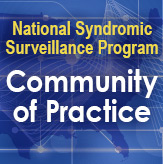Technical Updates

JHU–APL Performs Comprehensive Assessment of
BioSense Platform
Developers with the Johns Hopkins University Applied Physics Laboratory (JHU–APL) have completed and delivered a comprehensive assessment of the BioSense Platform. Their assessment will guide decision-making for improving the platform’s underlying cloud architecture, balancing the cost of implementation against platform performance, capability, and scalability.
Over the next few months, the NSSP team will develop a roadmap for implementing many of the recommendations. Further, JHU–APL developers are improving the ESSENCE user interface and working on some exciting advanced analytic methods for eventual use on the BioSense Platform.
NSSP Improves Shiny R-based Data Quality Dashboard
The NSSP development team has improved the Shiny R-based Data Quality (DQ) Dashboard to allow faceting and stratification of completeness and timeliness measures. These capabilities should help site administrators who rely on the dashboard to see how their site’s data quality measures up to NSSP standards. The team continues to build out the DQ Dashboard in the staging environment. Eventually, these DQ Dashboard tools will be available for onboarding new facilities.
AMC Release Implemented in January
Maintenance release 1.5.5.4 for the Access & Management Center (AMC) provided a fix for the Master Facility Table (MFT) interface that is used by site administrators to record information about reporting facilities. The Cancel Requested Changes button in the Facility Review section now works as expected.
In addition, the Knowledge Repository software and several AMC software components were upgraded to enhance security.
March Update to AMC is Underway
Ongoing improvements to the AMC are underway for a March 2022 release. Updates will include a batch upload and edit feature for facility data and improved methods for conducting validation checks.
Onboarding Updates
Update on Federal Data in Production
In 2018, a pilot project was launched to develop best practices for using one system to access and share syndromic data from federal sources with local public health jurisdictions. This collaboration involved health practitioners from the Department of Defense (DoD), the Virginia Department of Health (VDH), and the National Syndromic Surveillance Program (NSSP). Project participants concluded that by combining federal and local syndromic data, the public health response to outbreaks and emerging infectious disease affecting civilian and military populations could be vastly improved. The findings and success of this pilot project led to additional launches in Arizona and North Carolina.
In 2020, the Department of Veterans Affairs began sending data to the NSSP BioSense Platform, with data available from August 2018. The goal is to eventually share data with all sites.
► How can my health department benefit from federal syndromic surveillance data?
If your health department is in an area with large military installations, these data will provide insight into health events affecting military populations with the potential to affect their families, friends, and others in the community.
► Are other federal sources planning to share data?
The Department of Veterans Affairs is working toward data-sharing readiness. Updates will be provided when available.
► How can my site begin data sharing with federal sources?
The DoD continues to explore data-sharing opportunities with sites. Information about the DoD data-sharing process was provided at the July 2021 NSSP Community of Practice call. The recordings and slides were posted in the Knowledge Repository (see monthly calls).
To begin the process of accessing federal data, please submit a ticket to the NSSP Service Desk.
NSSP is Onboarding Northern Mariana Islands
The NSSP onboarding team is actively working with Northern Mariana Islands to establish a connection and onboard facilities to the BioSense Platform.
NSSP Updates API Guide
We added new functionality to How to Use RStudio with NSSP-ESSENCE APIs. This living document describes the application programming interfaces (APIs) available in ESSENCE and explains how to access them via the Rnssp package. The document includes code for installing Rnssp, loading the packages, and using seven ESSENCE APIs.
The updates enable you to pull
- values of query fields (i.e., all ESSENCE syndrome definitions);
- word alerts; and
- time-chunked data to acquire details, accompanied by an example.
The latest fix included in this update ensures that the keyring library functions work as intended. NSSP developers temporarily removed the keyring library functions after receiving complaints and reading concerns posted on the Slack workspace (request to join Slack here).
The API guide is posted as a mark-down document in the NSSP CoP Knowledge Repository. You can also link to it from the NSSP’s Technical Tips and Training web page.

